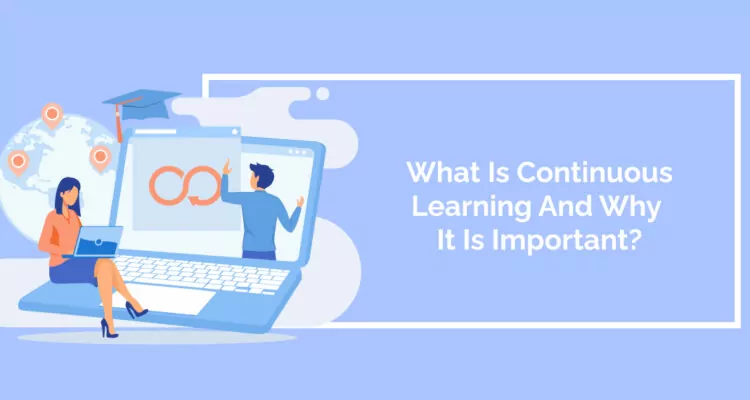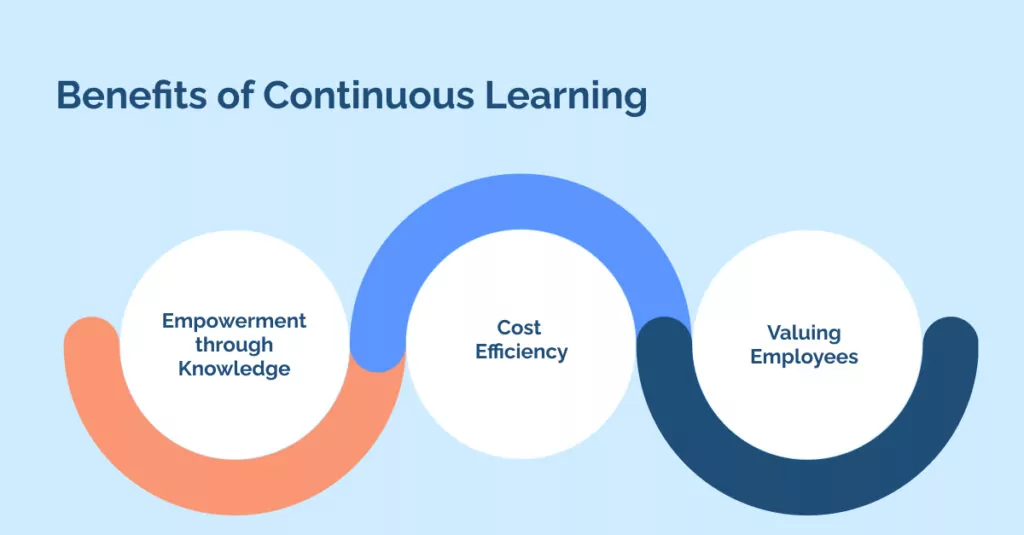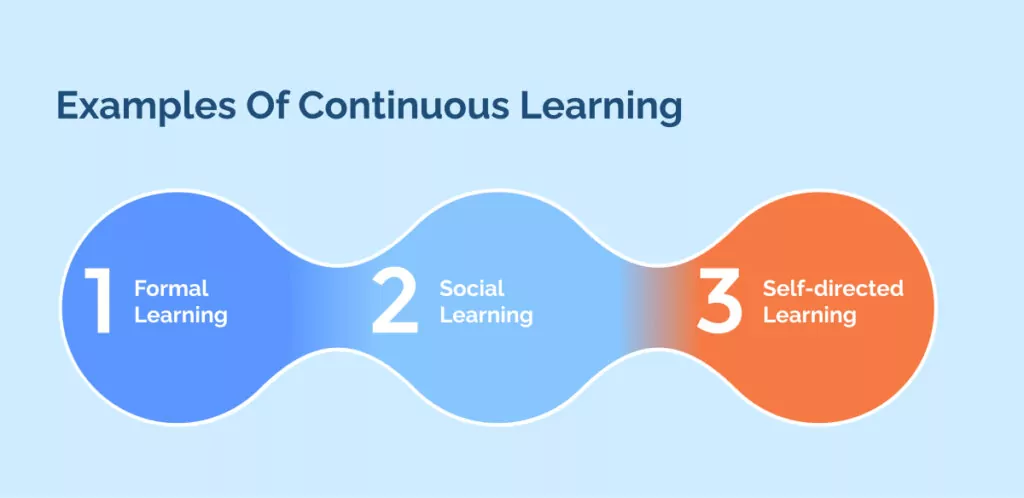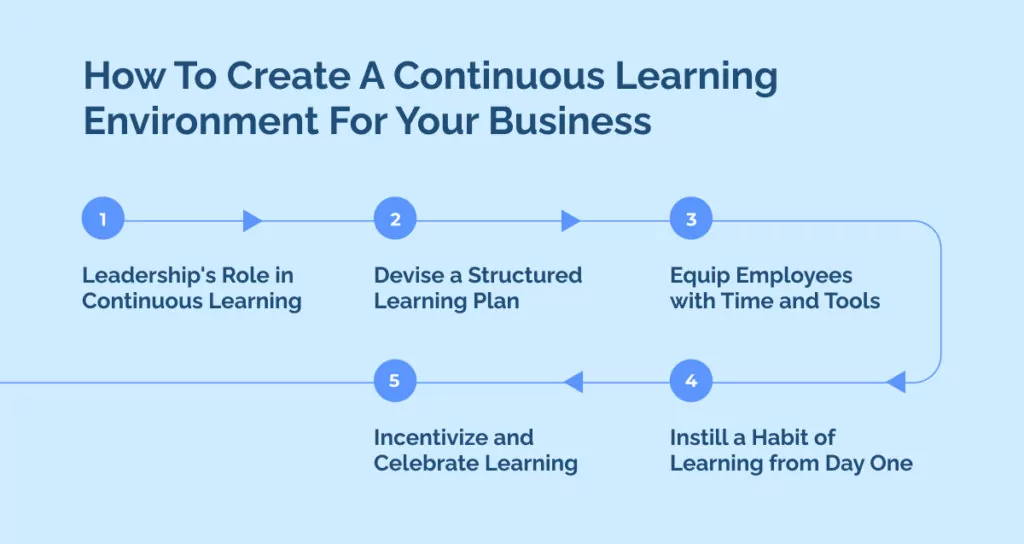
Continuous learning involves an employee consistently acquiring new skills, knowledge, and insights.
It reflects an individual’s continuous growth in response to both the needs of their organization and broader industry trends, as well as global changes.
Your team can more efficiently and enthusiastically champion your company’s objectives and vision when equipped with up-to-date and relevant knowledge.
Even with a solid onboarding program, it’s not guaranteed that employees will remain loyal forever. Without consistent efforts to enhance and nurture employee development, there’s a risk of disengaging them, making employee churn more likely.
Seeing professional growth as a one-time event rather than constant learning puts you at a disadvantage, allowing competitors to overtake you. This mindset can also leave your team lacking enthusiasm and unprepared for technological or industry shifts.
Many businesses embrace a continuous learning culture to keep the enthusiasm sparked during onboarding and ensure long-term employee engagement.
In this guide, you will learn:
- What continuous learning is and why it is important
- The benefits of continuous learning
- The difference between lifelong learning and continuous learning
- The various examples of continuous learning
- How to create a continuous learning strategy for your business
What Is Continous Learning?
Continuous learning involves continually enhancing a professional individual’s skills and knowledge.
Commonly linked with professional growth, it encompasses acquiring new abilities and insights in the professional realm and refining previously acquired knowledge. The scope of continuous learning is vast, spanning from formal to informal and from structured to flexible approaches.
Such activities include enrolling in a formal class, learning from seasoned colleagues, seeking help on unfamiliar subjects, experimenting with novel work techniques, reading, engaging in enlightening discussions, or refining a specific skill through practice.
Continuous learning is also associated with a learning organization, an innovative culture, and a focus on continually improving products, services, and processes.
It can help employees navigate the digital learning curve for enhanced organizational change.
Why Is Continuous Learning Important?
Continuous learning elevates an organization’s collective knowledge and maintains this peak through regular reinforcement activities. In conventional training models, there’s a surge in employee knowledge post-training, but it typically wanes over time without consistent reinforcement.
With continuous learning, the enhancement of employee knowledge is cumulative, stemming from various learning events.
In order to stay competitive, businesses must be innovative, adaptable, and constantly evolving.
With endorsing an ongoing learning culture, innovation will continue, processes will continue, and progress will continue.
Benefits of Continuous Learning

Establishing a culture of learning within an organization bolsters performance and innovation, as previously highlighted, and enhances employee contentment and retention.
Here are the main ways that organizations benefit from continuous learning:
- Empowerment through Knowledge: The better informed and skilled employees are, the more they can contribute to the organization’s success.
- Cost Efficiency: Investing in employee growth is more economical than the costs associated with hiring and training new staff.
- Valuing Employees: Championing continuous learning signifies that the organization values its employees and is committed to their career development.
Additionally, continual learning can also benefit employees in a myriad of ways by assisting in:
- Becoming a Top Performer: Acquiring new skills and knowledge can enhance efficiency and effectiveness at work.
- Career Advancement: Pursuing further training or skill enhancement can pave the way for career aspirations or transitioning to a different role.
- Acquiring Licenses or Certifications: Continuous learning is crucial for securing or renewing professional licenses or certifications.
- Elevated Opportunities: Dedication to learning can boost job performance, leading to promotions or financial rewards.
- Personal Growth: Learning outside one’s regular job can provide insights and opportunities that align with personal passions or future career shifts.
- Staying Relevant: Keeping up-to-date with the latest in one’s field ensures that an employee remains a valuable asset, especially during unforeseen changes.
- Broadening Horizons: Engaging in continuous learning enriches your mindset, reshaping your perceptions based on expanding knowledge. As employees learn more information, they become adept at viewing situations from multiple angles, fostering deeper comprehension.
The Difference Between Lifelong Learning And Continuous Learning
“Lifelong learning” and “continuous learning” are terms that are frequently used interchangeably.
However, their nuances can differ based on the context in which they are used.
Here’s a breakdown of the distinctions:
Lifelong Learning
Lifelong learning predominantly focuses on the individual. It alludes to the enduring, self-motivated pursuit of knowledge for personal or professional development.
A person who engages in lifelong learning integrates this continuous quest for knowledge into their daily life.
For instance, a lifelong learner might make it a habit to read about diverse topics for an hour each day. This commitment stems from personal interest and the aspiration for self-growth and ongoing enrichment.
Continuous Learning
While continuous learning can also pertain to an individual’s commitment to acquiring new skills or knowledge, it’s often seen in more immediate or structured scenarios.
For example, continuous learning might involve an employee enrolling in a supplementary training course relevant to their current profession. Usually formal and sometimes temporary, this act is pursued to master specific skills or knowledge.
Examples Of Continuous Learning

These are various avenues through which an employee can pursue a continuous learning program.
Examples of the types of continuous learning are:
Formal Learning
Formal learning refers to structured educational experiences designed with a specific learning objective.
Examples include:
- Courses from universities or colleges
- Internal organizational training courses
- Conferences or external workshops
- Online learning courses
- Mobile-based learning modules
- Massive Open Online Courses (MOOCs)
Social Learning
Social learning encompasses learning through interaction, collaboration, and discussion with others. It can be both structured and informal.
Methods include:
- Engaging in discussions on social media platforms
- Delving into informative blogs or resources for deeper insights
- Collaborating with colleagues
- Benefitting from coaching or mentoring sessions
- Hands-on training at the workplace
Self-directed Learning
This involves an individual taking the initiative to seek knowledge or skills without the immediate guidance of an instructor.
It can involve:
- Intensive reading and research on particular subjects
- Tuning into relevant podcasts or viewing educational videos
- Experimenting and self-exploration of topics.
How To Create A Continuous Learning Environment For Your Business

Fostering a culture that endorses continuous learning in employees requires dedication, resources, and effective mentorship.
While some employees are naturally driven and pursue continuous learning independently, many may lack the resources or time or are primarily focused on their immediate job responsibilities.
Expecting all employees to immerse themselves in continuous learning, whether during office hours or their personal time, might be a tall order.
Given this backdrop, here are some strategies to cultivate a conducive learning environment:
Leadership’s Role in Continuous Learning
The tone for continuous learning is set at the top. When staff see leaders actively participating in and championing development initiatives, it sets an example of change readiness.
If employees feel taking time for learning might be frowned upon by management, they’ll likely avoid it. Leaders must lead by example.
Devise a Structured Learning Plan
Embedding continuous learning opportunities into the organizational fabric ensures better engagement. Outlining the company’s objectives for learning and devising a roadmap to achieve those can be effective.
Open conversations around learning emphasize the organization’s commitment and ensure employees realize the tangible steps taken to promote it. This plan could encompass resources required or learning modes like mobile education or mentorships.
Equip Employees with Time and Tools
The backbone of a thriving learning culture lies in allocating adequate time and resources.
Depending on the organization’s or individual’s needs, this can manifest in various ways:
- Craft a personal growth plan for each employee to spotlight areas of interest and learning.
- Organize ‘Lunch & Learn’ sessions for employees to share and apply newfound knowledge.
- Allocate specific hours for learning.
- Facilitate team workshops or seminars.
- Offer access to professional tools, memberships, or online self-paced courses.
- Arrange for mentorship programs.
- Set up a dedicated learning committee to delve deep into topics and foster collaboration.
Instill a Habit of Learning from Day One
Enduring success in continuous learning hinges on routine. New hires should not only expect training but should also desire it. Kickstarting this culture right from the onboarding phase can set the right expectations, showcasing learning as an integral part of the company ethos.
Incentivize and Celebrate Learning
Transitioning to a continuous learning ethos can have its challenges. However, accelerating its adoption can be made easier with incentives.
Consider rewarding top learners with perks or use gamified elements in your Learning Management System (LMS) to spur enthusiasm. Recognizing and rewarding learning efforts can go a long way in ensuring its integration into the organizational culture.
Final Thoughts On Continuous Learning
Continuous learning encompasses ongoing educational and professional growth opportunities throughout one’s career. These experiences not only keep you informed about the latest developments in your field but also enhance your expertise in crucial domains.
Beyond its individual benefits, the culture of perpetual learning and growth significantly contributes to the success of businesses. It fuels expansion and opens doors to diverse opportunities. Whether through formalized learning management systems (LMS) or more spontaneous and informal methods, the emphasis on continuous learning is vital for enterprise success.
Businesses that aspire to lead their respective sectors must become agile learning entities, possessing an unparalleled ability to learn, innovate, and improve with efficiency and speed, outpacing their competitors.
Fostering innovation requires a dedicated investment of time and resources. Every member of the organization should actively seek and implement subtle improvements, with leadership emphasizing and championing these efforts.
To promote continuous learning, organizations should create a supportive environment where employees are encouraged to seize learning opportunities, even amidst their busy schedules.
Thus, clear organizational commitment, tailored learning pathways, and change management communication are essential.
Since culture starts at the top, leadership should actively champion and engage in continuous learning, ensuring resources and a consistent emphasis on development.
WalkMe Team
WalkMe spearheaded the Digital Adoption Platform (DAP) for associations to use the maximum capacity of their advanced resources. Utilizing man-made consciousness, AI, and context-oriented direction, WalkMe adds a powerful UI layer to raise the computerized proficiency, everything being equal.



